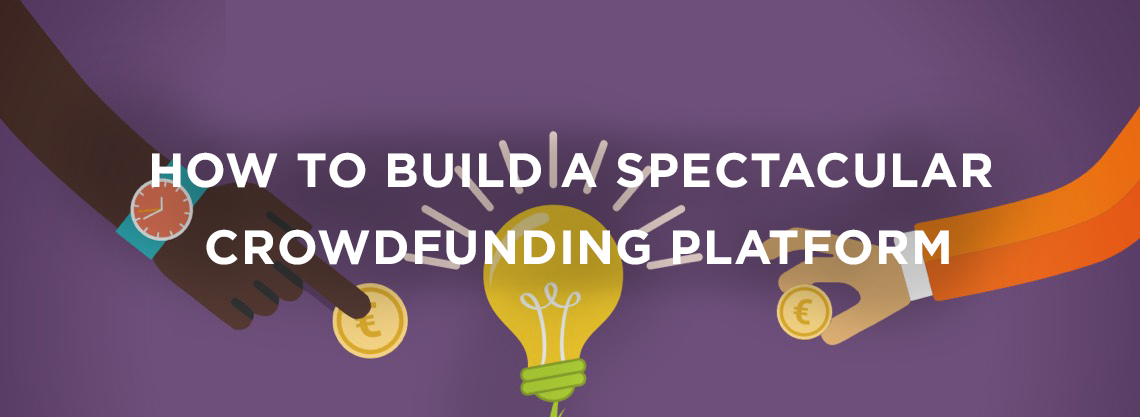Crowdfunding has both reversed the traditional view on funding and taken it to a whole new level. It has not only made funding a great deal easier to secure, but it has also made it available for a plethora of ventures and projects that could otherwise hardly ever count on getting funded at all. While this may sound like something that can make a meaningful impact on the global community of entrepreneurs, let’s find out what it takes to build your own crowdfunding platform.
With a staggering $34,400,000,000 invested by means of crowd-funding in various nascent businesses in 2015 (notably, against only $2,700,000,000 just three years previously) crowdfunding is justifiably eyed up by many IT investors as their next logical move. In this sense, the Crowdfunding industry’s front-runner Kickstarter is regarded by many as the embodiment of success in the captioned business domain. With an array of ultimately impressive statistics which range from a total of more than 133 000 crowdfunded projects to more than $3,360,000,000 pledged via the platform, Kickstarter seems to be worth the attention of anyone who wants to know how to make a crowdfunding website. So, how does the platform work?
How does Kickstarter work?
Kickstarter is a crowdfunding platform, designed to crowdfund creative projects.
Just like the vast majority of other crowdfunding platforms, Kickstarter allows entrepreneurs to create detailed online presentations of their projects that feature videos. This crowdfunding infrastructure is centered around the reward-based investor revenue model (usually, the investor revenue models include reward-based, loan-based, donation-based, and equity-based ones) and, unlike some other websites, such as, for instance, well-known crowdfunding platform Indiegogo, uses only the all-for-nothing investment threshold model. In accordance with the latter, a crowdfunding campaign becomes valid only when the target investment amount is reached.
Kickstarter allows project owners to conveniently track their funding progress, interact with their investors, referred to as “backers” and, eventually, to build a community around their products. They can receive feedback from friends and send rewards. The platform collects a fee of 5 % of the crowdfunded amount.
The ability to accept payments from backers of Kickstarter projects is fundamental to the platform’s performance. Therefore, Kickstarter relies on APIs to simplify payment processing and raised funds distribution.
This is, more or less, what the whole thing is about, just in a nutshell. So…
How to make a website like Kickstarter?
So, how to build a crowdfunding platform and make it, at least, partially as successful, as Kickstarter? Does it make sense to just find white-label crowdfunding software for sale? Is it a workable solution emulate this or any other well-known crowdfunding platform, or should any other approach be taken?
Our team has been heavily involved in developing one of Sweden’s leading crowdfunding platforms for quite a long time now. We are convinced that building a truly powerful and engaging crowdfunding app takes a custom approach and quite a bit of creativity. Unless you want to be just another small-timer, a run-off-the-mill won’t do.
Just like in most business niches, to launch crowdfunding on your own website, you must, firstly, have clearly set goals and, secondly, be aware of the numerous nuances that can make or break your crowdfunding startup.
Let’s take a closer look at what you should, as we believe, factor in before you put together a team of crowdfunding software developers and kick-start creating a crowdfunding platform.
1. Make sure the existing crowdfunding platforms fall short in your case
The very first thing you should do if you are considering crowdfunding platform development is take a look at the existing white label and open-source options. In some instances, this helps save a bundle on not having to reinvent the wheel. Certainly, you are unlikely to be able to get something large-scale like Kickstarter, but for some business purposes and market niches, you may well be able to satisfy your needs with a good white label.
However, if the scale of your aspirations is larger than any of the white-label functionality available out there, or you are just not a QA buff to continually engage in tweaking the often bug-infested open-source apps, custom crowdfunding platform development is the only viable option you are facing.

2. Clearly define your target audience and corresponding investor revenue model
If you want to create your own crowdfunding website, the investor revenue model is at the core of it all. Any crowdfunding platform is built around one (or more) investor revenue model that is more about keeping with the needs and preferences of its target audience.
The most well-known investor revenue models include equity-based, loan-based, donation-based, and reward-based models, as well as several hybrid variations thereof. It is important to understand that the range of investor revenue models does not only dictate that the set of the functionality should be developed for supporting the corresponding revenue channels, but it also affects the design of the application as a whole, including its look and its feeling.
For example, if you are targeting music fans who want to become part of a future legend by chipping in on the new releases of bands that take their fancy, you may want to limit the investor revenue-related functionality of your crowdfunding website to what is required to support the reward-based model only. On the other hand, you should then be prepared to spend more on the app’s UI / UX in order to gin up your audience’s interest and make the app stand out from the pack.
Conversely, if your focus is on business investors, be prepared to invest more in both the revenue generation and equity management functionality, and not on the look and feel of your crowdfunding site. Thus, for example, in the first part of 2019, Kickstarter generated more than $4 billion in revenue and it is a huge sum of money to deal with.
3. Take a nuanced approach to the implementation of the crowdfunding investment cycle
While most of your entrepreneur clients will expect an avalanche of investors to start beating around the door as soon as they post their presentation on your crowdfunding site, the reality may be somewhat different. It is difficult for most crowdfunded projects to secure funding before they’ve reached the 30% investment threshold.
Moreover, there’s another tendency that cannot be overlooked: consciously or subconsciously, a vast number of your startup clients will expect your crowdfunding platform to do their marketing for them. But crowdfunding technology does not involve the marketing of the submitted projects per se. In such cases (and you can well expect them to be significant in number as the popularity of your platform grows), a crowdfunding campaign failure may well entail blame-shifting or just negatively affect your brand loyalty and customer retention. Thus, both the above scenarios should be taken into account prior to when your platform development is underway.
There are two things you can do to help the situation. First of all, you must enable crowdfunding campaigns to run in a kind of stealth mode. This means that when a client of yours starts crowdfunding, they must be afforded the option of restricting their crowdfunding campaign’s accessibility. The campaign must then be available only to a limited number of prospective investors the client wants to invite. These prospective investors, normally, include family, friends, business associates, and more. It will, thus, be necessary to integrate the campaign-related functionality of your crowdfunding app with as many social networks as possible. The user must also be able to send invitations by email. Certainly, as far as possible, early-stage investments from the client’s friends and family should be handled by your crowdfunding platform gratis.
Additionally, you can also implement a mode that will allow startuppers to place campaign-related ads (announcements) in advance, indicating the start dates for their campaigns. Startuppers should also be allowed to post articles bearing on their startup ideas in the news feed of your crowdfunding platform. Such a news feed would be another great thing to implement, especially for customer retention purposes.

4. Implement support for a stage-by-stage / incremental crowdfunding cycle
There are business ideas that can and should best be implemented in stages in order to reduce the resulting product’s time-to-market and make it start earning a profit faster. This should be opted for whenever possible: it is significantly easier for a startup to attract sufficient funds for each of the project’s constituent stages than the entire amount at once.
Correspondingly, while creating a crowdfunding platform, you should implement functionality that allows splitting a startup project into stages, each of those having a separate funding goal.
5. Make the equity management functionality of your crowdfunding website sophisticated enough
There are two main reasons why it makes sense to make your equity management functionality as advanced as possible. Firstly, the equity-based investor revenue model is one of several principal investor revenue models. Thus, this model must necessarily be taken into account if you want to build a crowdfunding platform that enables business crowdfunding in earnest.
Secondly, it is a crowdfunding infrastructure that defines the functionalities of the site. So, a well-developed infrastructure and therefore well-implemented equity management functionality can become your crowdfunding website’s best investor retention incentive. Why? Because when you buy equity you also buy a bit of an additional headache. This headache is caused by the need to manage the purchased equity and to ensure related legal compliance. Giving your investors a tool that would allow them to comprehensively address the above issues can help you keep them on your crowdfunding website and, in due course, engage them in more crowdfunding deals.
Similarly, you can give your services a greater appeal by finessing on your crowdfunding app’s functionality, intended for dealing with equity holders. For instance, it would be smart of you to implement the Fixed Equity Amount and Equity Amount Range options in order to enable entrepreneurs to flexibly adjust the amount of a single investment to one they will be comfortable with. Unless your start-up clients fancy a great lot of investor attention, this approach can spare them the hassle of having to deal with a crowd of petty investors, each of those having their own expectations, communication habits and jam-packed schedules.
Incidentally, adding functionality for the management of equity holder relationships would definitely be an additional asset for your crowdfunding platform.
6. Beef up the potential of your crowdfunding platform with Artificial Intelligence
In due time, Artificial Intelligence may prove to be as disruptive to the crowdfunding industry, as it is becoming now to many other industries. However, already at this point, there are several applications of AI someone embarking on fundraising website development should be aware of.
For example, in addition to the boilerplate information on a startup and its founders, retrieved by your platform from sources like a government database, the AI technique called Natural Language Processing (NLP) can also help your investors find out more about the startup founders and the buzz around their previous business undertakings. To enable this, an NLP-driven module can scour the Web for all related mentions and give you some additional insights into whether those you are going to invest in are, actually, capable of bringing their business ideas to life.
Similarly, NLP can allow your investor clients to size up how innovative the startup idea they are considering investing in is. This can be done both by means of a Web search and by means of a patent-related search.
NLP can also make the continuous feed and company-following functionality of your fundraising software a great deal more interesting and engaging. For example, it would be possible to glean from across the Web and display in the app’s continuous feed various news items and other information, associated with the companies and projects the user is following.

With the help of Machine Learning–driven functionality, you can give your crowdfunding platform the ability to score crowdfunding projects based on the historical data it has amassed. Simply put, the platform will be able to identify similarities between this and preceding similar projects and calculate such insightful indicators, as, for example, the overall probability of the product getting funded or the probability of it getting funded within the stipulated period of time. This ability can also be useful for the definition of the span of time, required for reaching an investment goal, and raising a certain amount in crowdfunding on sites like Kickstarter - something startuppers might be thankful to you for implementing.
Another great way to improve your crowdfunding website and enhance its client engagement ability immeasurably would be to implement an AI-driven chatbot. In addition to enabling a large number of personalized conversations with clients that may be necessary or desirable, such a conversational bot could be geared toward acquainting your clients with similar investment opportunities and swaying their interest in making further investments.
Lastly and importantly, it is advisable that you entrust your crowdfunding website development to a software provider with relevant previous experience. This is likely to help you avoid the many pitfalls that are still lurking along this seemingly well-trodden path and, perhaps, even to enrich your undertaking with ideas that will help it succeed.

© 2019, Vilmate LLC




